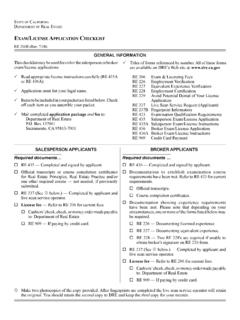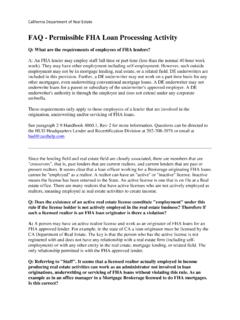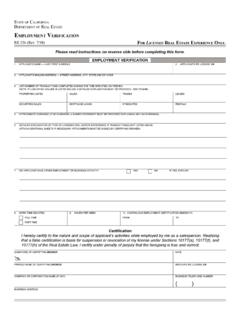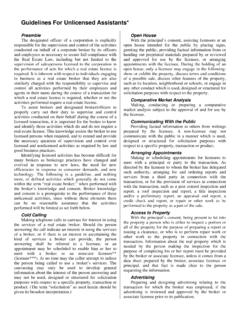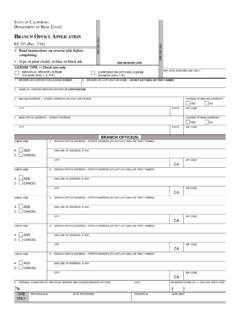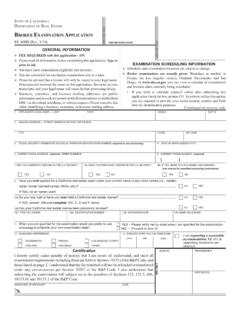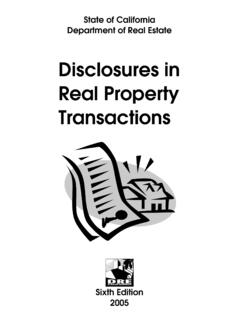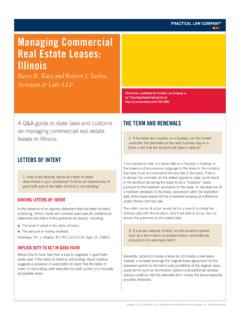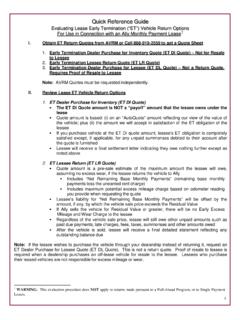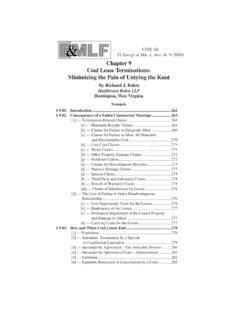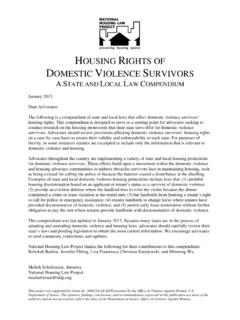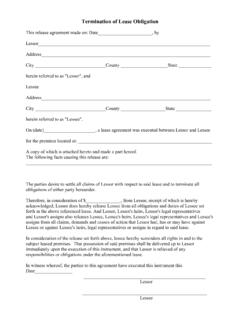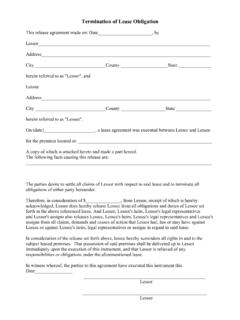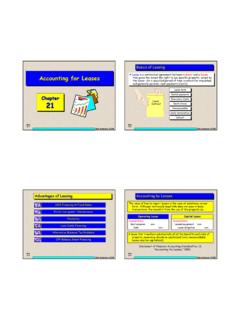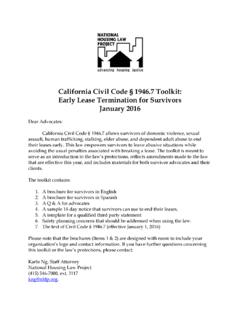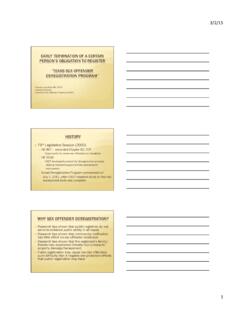Transcription of 9 Landlord and Tenant - California Bureau of Real Estate
1 9 landlord and tenant The distinguishing feature of a leasehold interest is the right to exclusive possession and use of real property, for a fixed period of time, held by the lessee (or Tenant ). The lessor (or Landlord ), having parted with this right to exclusive possession, merely holds the basic title (the reversion ) during the existence of the lease . Hotel guests, licensees and employees may all be privileged to use a given space under certain contractual conditions, but since none of these has an exclusive right to possession, they are not governed by the laws regulating the relationship of Landlord and Tenant . A leasehold Estate itself is chattel real .
2 Although the lessee has an Estate /interest in real property, the Estate is in fact a form of personal property, governed by laws applicable to personal property. Types of Leasehold Estates Most authorities classify leases into four categories, based on the lease term: Estate for years; Estate from period to period (periodic tenancy); Estate at will; and Estate at sufferance. Estate for years. An Estate for years is one which is to continue for a definite period fixed in advance by agreement between Landlord and Tenant . The name is somewhat misleading because the period may be for less than a year, measured in specific days, weeks, or months.
3 Estate from period to period. An Estate from period to period (or periodic tenancy) is one which continues for periods of time (typically year-to-year, month-to-month, or week-to-week) as designated by Landlord and Tenant in their agreement. The most common periodic tenancy is the month-to-month tenancy. Estate at will. An Estate at will is one which is terminable at the will or unilateral decision of either party with no designated period of duration. Tenancies at will are uncommon because the Landlord s acceptance of periodic rents causes the tenancy to be treated like a periodic tenancy (Civil Code Section 1946). By statute, California and certain other states have modified the potentially summary and abrupt conclusion of such estates to require advance 30-day notice of termination by either party.
4 Estate at sufferance. An Estate at sufferance is one in which the Tenant who has rightfully come into possession of the land retains possession after the expiration of the term. For example, a Tenant who holds over after the expiration of a lease would be deemed to be holding an Estate at sufferance. Dual Legal Nature of lease A lease is an oral or written agreement that creates and governs, by express or implied terms, a Landlord - Tenant relationship. A lease has two characteristics, each of which has its own set of rights and obligations : 1. a conveyance by the Landlord to the Tenant of an Estate in real property covering the premises leased (which creates privity of Estate between the Landlord and Tenant ); and 2.
5 A contract between the Landlord and Tenant which governs both the Landlord s delivery and maintenance of the premises and the Tenant s possession of, use of, and payments for the premises (which creates privity of contract between the Landlord and Tenant ). Verbal and Written Agreements A lease with a term of one year or less may be created by verbal agreement. However, for the sake of clarity and to reduce the risk of disagreement (both during the lease term and after Tenant s surrender of the premises), all leases, even those with month-to-month terms, should be reduced to written form. California s Statute of Frauds requires a lease to be in writing if it either: 1.
6 Has a term longer than one year; or 2. has a term less than one year which expires more than one year after the agreement is reached. An example of a lease with a term of less than one year that must be in writing is a lease for a ten month term that begins three months from the date when an agreement is reached. Although one might automatically assume CHAPTER NINE 130 that the lease would not need to be in writing since it is for a term of less than one year, the contractual relationship (which will exist during the three month pre-tenancy period and the ten month term of lease ) will actually be maintained for thirteen months. Unwritten leases that are for a term of longer than one year or that expire more than one year after the agreement is reached are unenforceable.
7 If a Tenant enters into possession under an unenforceable lease , the Tenant becomes a Tenant at-will. lease Ingredients No particular words, form, or language are required to create an oral or written lease . However, the words used must: 1. evidence the Landlord s and Tenant s intent to create a Landlord - Tenant relationship (which intent is apparent from either the parties acts or deeds, or the language of a written agreement); 2. identify the parties; 3. describe the premises leased; 4. specify the time, amount, and manner of rental payments; and 5. establish a definite term. Contract and Conveyance Issues In light of its dual character of being a contract and a conveyance, an enforceable lease must satisfy specific laws with respect to: 1.
8 The creation and interpretation of a contract; and 2. the prerequisites for the transfer of an interest in real property. Contract specifics. The general rules regarding the creation of a lease (and contract), in addition to those governing whether or not there must be a writing, include: 1. mutual assent of Landlord and Tenant ( , an offer and an acceptance); 2. mutuality of obligation ( , neither party may have an unrestricted right to withdraw from the lease ); 3. legal capacity of each party to contract (which, in general, excludes minors, persons of unsound mind, and persons deprived of their civil rights); and 4. lawful object ( , use does not violate health and safety regulations or criminal statutes).
9 Although a lease may, indeed, have a lawful object, specific provisions within the lease may be deemed against public policy and therefor void. For example, residential leases that waive Tenant procedural rights (such as the right to receive a notice of default) or rights regarding security deposits; or waive any future course of action against the Landlord . As a contract, a written lease is construed according to the intent of the parties, as gathered from the language of the lease and the performance of the parties under the lease , and in accordance with the rules of interpretation of contracts. Furthermore, like other written contracts, the executory (yet to be performed) provisions of a written lease may not be orally modified.
10 Rather, such provisions must be modified in a writing signed by all parties to the original lease . To the extent that the parties mutually agree to modify the lease with respect to fully performed lease obligations , such modifications become executed modifications of the lease . When a lease is negotiated in Spanish and is for a residential unit, the lease must be written in Spanish. Execution, delivery and acceptance. In general, a written lease must be executed, delivered, and accepted before it may be enforced according to its express terms. However, a lease signed and delivered by the Landlord is enforceable by the Tenant even if the Tenant fails to sign the lease .

